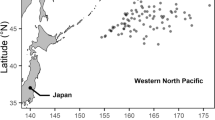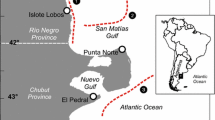Abstract
The commercially and ecologically valuable sandeel (Ammodytes ssp.) make distinct vertical shifts between an inactive stage, during which they seek refuge in the sand, and a pelagic schooling stage, during which they forage. This characteristic discontinuous foraging pattern constitutes a challenge to fishery biologists and has consequences for a wide range of predators ranging from birds and mammals to commercially important species. However, experimental studies that shed light on the primary drivers of foraging activity in fish are rare. In the present study, whole schools of sandeel (A. tobianus) were caught in August in east Denmark (65°02′30N; 12°37′00E) and kept in large tanks in the laboratory. It was found that the amount of food ingested and memory of past days feeding history are primary drivers of foraging activity at the level of the entire school, whereas external factors such as prey concentration and temperature are merely secondary drivers.






Similar content being viewed by others
References
Behrens JW, Petersen JK, AErtebjerg G, Steffensen JF (2010) Influence of moderate and severe hypoxia on the diurnal activity pattern of lesser sandeel Ammodytes tobianus. J Fish Biol 77:538–551
Bohl E (1980) Diel pattern of pelagic distribution and feeding in planktivorous fish. Oecologia 44:368–375
Boujard T, Leatherland JF (1992) Circadian-rhythms and feeding time in fishes. Environ Biol Fish 35:109–131
Bremset G (2000) Seasonal and diel changes in behaviour, microhabitat use and preferences by young pool-dwelling Atlantic salmon, Salmo salar, and brown trout, Salmo trutta. Environ Biol Fish 59:163–179
Cardinale M, Casini M, Arrhenius F, Hakansson N (2003) Diel spatial distribution and feeding activity of herring (Clupea harengus) and sprat (Sprattus sprattus) in the Baltic Sea. Aquat Liv Res 16:283–292
Darbyson E, Swain DP, Chabot D, Castonguay M (2003) Diel variation in feeding rate and prey composition of herring and mackerel in the southern Gulf of St Lawrence. J Fish Biol 63:1235–1257
Drickamer LC, Gillie LL (1998) Integrating proximate and ultimate causation in the study of vertebrate behavior: methods considerations. Am Zool 38:43–58
Engelhard GH, van der Kooij J, Bell ED, Pinnegar JK, Blanchard JL, Mackinson S, Righton DA (2008) Fishing mortality versus natural predation on diurnally migrating sandeels Ammodytes marinus. Mar Ecol Prog Ser 369:213–227
Freeman S, Mackinson S, Flatt R (2004) Diel patterns in the habitat utilisation of sandeels revealed using integrated acoustic surveys. J Exp Mar Biol Ecol 305:141–154
Furness RW (2002) Management implications of interactions between fisheries and sandeel-dependent seabirds and seals in the North Sea. Ices J Mar Sci 59:261–269
Giske J, Mangel M, Jakobsen P, Huse G, Wilcox C, Strand E (2003) Explicit trade-off rules in proximate adaptive agents. Evol Ecol Res 5:835–865
Greenstreet SPR, Armstrong E, Mosegaard H, Jensen H, Gibb IM, Fraser HM, Scott BE, Holland GJ, Sharples J (2006) Variation in the abundance of sandeels Ammodytes marinus off southeast Scotland: an evaluation of area-closure fisheries management and stock abundance assessment methods. Ices J Mar Sci 63:1530–1550
Hobson ES (1986) Predation on the Pacific Sand Lance, Ammodytes hexapterus (Pisces, Ammodytidae), during the transition between day and night in Southeastern Alaska. Copeia 1986(1):223–226
Loekkeborg S (1998) Feeding behaviour of cod, Gadus morhua: activity rhythm and chemically mediated food search. Anim Behav 56:371–378
Macer CT (1966) Sandeels (Ammodytidae) in the south-western North Sea: their biology and fishery. MAFF Fish Invest Lond Ser II 24:1–55
Marchand F, Magnan P, Boisclair D (2002) Water temperature, light intensity and zooplankton density and the feeding activity of juvenile brook charr (Salvelinus fontinalis). Freshw Biol 47:2153–2162
Nilsson LAF, Thygesen UH, Lundgren B, Nielsen BF, Nielsen JR, Beyer JE (2003) Vertical migration and dispersion of sprat (Sprattus sprattus) and herring (Clupea harengus) schools at dusk in the Baltic Sea. Aquat Liv Res 16:317–324
Rands SA, Cowlishaw G, Pettifor RA, Rowcliffe JM, Johnstone RA (2003) Spontaneous emergence of leaders and followers in foraging pairs. Nature 423:432–434
Rindorf A, Wanless S, Harris MP (2000) Effects of changes in sandeel availability on the reproductive output of seabirds. Mar Ecol Prog Ser 202:241–252
Salvanes AGV, Hart PJB (1998) Individual variability in state-dependent feeding behaviour in three-spined sticklebacks. Anim Behav 55:1349–1359
Tamm S (1989) Importance of energy costs in central place foraging by hummingbirds. Ecology 70:195–205
Valdimarsson SK, Metcalfe NB, Thorpe JE, Huntingford FA (1997) Seasonal changes in sheltering: effect of light and temperature on diel activity in juvenile salmon. Anim Behav 54:1405–1412
van der Kooij J, Scott BE, Mackinson S (2008) The effects of environmental factors on daytime sandeel distribution and abundance on the Dogger Bank. J Sea Res 60:201–209
van Dijk PLM, Staaks G, Hardewig I (2002) The effect of fasting and refeeding on temperature preference, activity and growth of roach, Rutilus rutilus. Oecologia 130:496–504
Winslade P (1974a) Behavioral-studies on lesser sandeel ammodytes marinus (Raitt).3. Effect of temperature on activity and environmental-control of annual cycle of activity. J Fish Biol 6:587–599
Winslade P (1974b) Behavioral-studies on lesser sandeel ammodytes marinus (Raitt).1. Effect of food availability on activity and role of olfaction in food detection. J Fish Biol 6:565–576
Winslade P (1974c) Behavioral-studies on lesser sandeel ammodytes marinus (Raitt).2. Effect of light-intensity on activity. J Fish Biol 6:577–586
Acknowledgments
All experiments were carried out in line with ethical guidelines on animal handling. We thank the two reviewers for their thorough and constructive critique, the personal at the Øresund Aquarium for helping us with catching and caretaking of sandeels and Ken Haste Andersen and Uffe Høgsbro Thygesen for help with MATLAB programming. MVD was funded by the Danish Research Council supported projects FISHNET and SLIP.
Author information
Authors and Affiliations
Corresponding author
Additional information
Communicated by C. Harrod.
Rights and permissions
About this article
Cite this article
van Deurs, M., Behrens, J.W., Warnar, T. et al. Primary versus secondary drivers of foraging activity in sandeel schools (Ammodytes tobianus). Mar Biol 158, 1781–1789 (2011). https://doi.org/10.1007/s00227-011-1691-x
Received:
Accepted:
Published:
Issue Date:
DOI: https://doi.org/10.1007/s00227-011-1691-x




